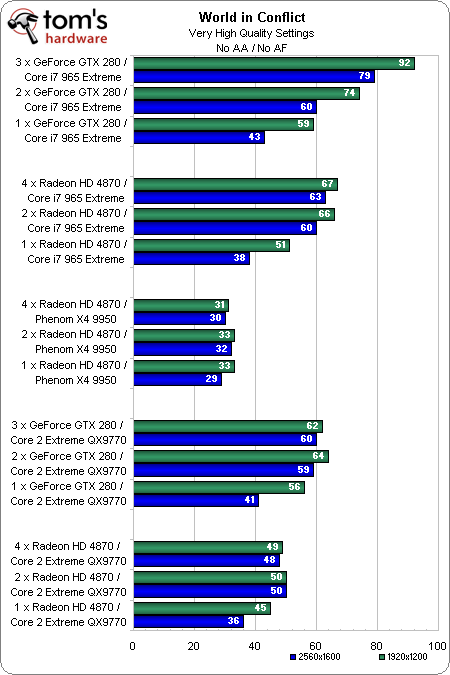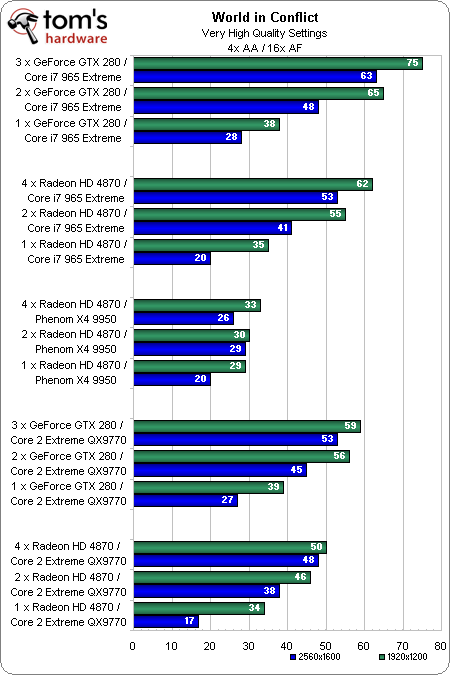Core i7: 4-Way CrossFire, 3-way SLI, Paradise?
Benchmark Results: World in Conflict
Each one of these charts has a lot of data, since we’re looking at five different platform permutations, each with three different graphics combinations and two resolutions. We’re going to break down the analysis for each game in detail, so hang in there as we explore how Core i7 stacks up against Core 2 Extreme and AMD’s Phenom X4 9950 in some of the most demanding titles out there.

Perhaps the most striking result here is that the AMD Phenom X4 9950 platform simply does not scale well. This is going to a theme we see carry over to a number of other benchmarks, so we’ll say it now and try to avoid repeating ourselves over and over. The quad-core chip performs well in its own regard, but it simply holds these high-end and ultra-high-end configurations back in almost every case.
Secondly, we can’t help but notice that, although Intel told us not to expect much in the way of faster gaming, we see excellent scaling from one to two to three GeForce GTX 280 boards in the Core i7-based configuration. In fact, once you move past a single board, the Core i7 965 Extreme gives the Nvidia cards much more room to breathe than Intel’s Core 2 Extreme QX 9770.
Likewise, AMD’s Radeon HD 4870s also get a fair bit of extra performance as we move from the X48-based system to X58. It’s interesting that the three GTX 280s beat four HD 4870s. But don’t worry if you’re an AMD enthusiast—these two graphics architectures trade blows throughout our benchmark suite and you’ll have situations where the Radeons come out on top, too.

Same situation here. Nvidia’s boards generally beat out AMD’s best efforts. And again, Core i7 does in fact enable reasonable scaling as you move from one to two or three GeForce GTX 280s. AMD’s Radeon HD 4870s also see marked scaling improvements all the way up to four RV770 GPUs. Core 2 Extreme QX9770 clearly holds these graphics architectures back versus Intel’s latest platform.
Get Tom's Hardware's best news and in-depth reviews, straight to your inbox.
Current page: Benchmark Results: World in Conflict
Prev Page Hardware Enthusiast’s Paradise Next Page Benchmark Results: Supreme Commander: Forged Alliance-
DFGum Yep, i hafta say being able to switch brands of graphics cards on a whim and selling off the old is great. Knowing im going to be getting the preformance these cards are capable of (better price to preformance ratio) is nice also.Reply -
cangelini randomizerSLI scales so nicely on X58.Reply
Hey you even got a "First" in there Randomizer! -
randomizer cangeliniHey you even got a "First" in there Randomizer!And modest old me didn't even mention it. :lol:Reply -
enewmen Still waiting for the 4870 X2s to be used in these bechmarks. I thought THG got a couple for the $4500 exteme system. But still happy to see articles like this so early!Reply -
cangelini enewmenStill waiting for the 4870 X2s to be used in these bechmarks. I thought THG got a couple for the $4500 exteme system. But still happy to see articles like this so early!Reply
Go check out the benchmark pages man! Every one with 1, 2, 4 4870s. The 2x and 4x configs are achieved with X2s, too.
Oh, and latest drivers all around, too. Crazy, I know! =) -
enewmen cangeliniI found it, just read the article too quickly. - My bad.Reply
"A single Radeon HD 4870 X2—representing our 2 x Radeon HD 4870 scores—is similarly capable of scaling fan speed on its own. "
Hope to see driver updates like you said. -
spyde Hi there, my question regarding these benchmarks with the HD card is, "was a 2G card use or a 1G". I am about to buy a new system and was looking to buy 2 x HD4870X2 2G cards, but with these results its looking a bit ify. I hope you can answer my question.Reply
Cheers. -
Proximon That's a nice article. I especially like the way the graphs are done. everything is scaled right, and you get an accurate representation.Reply
